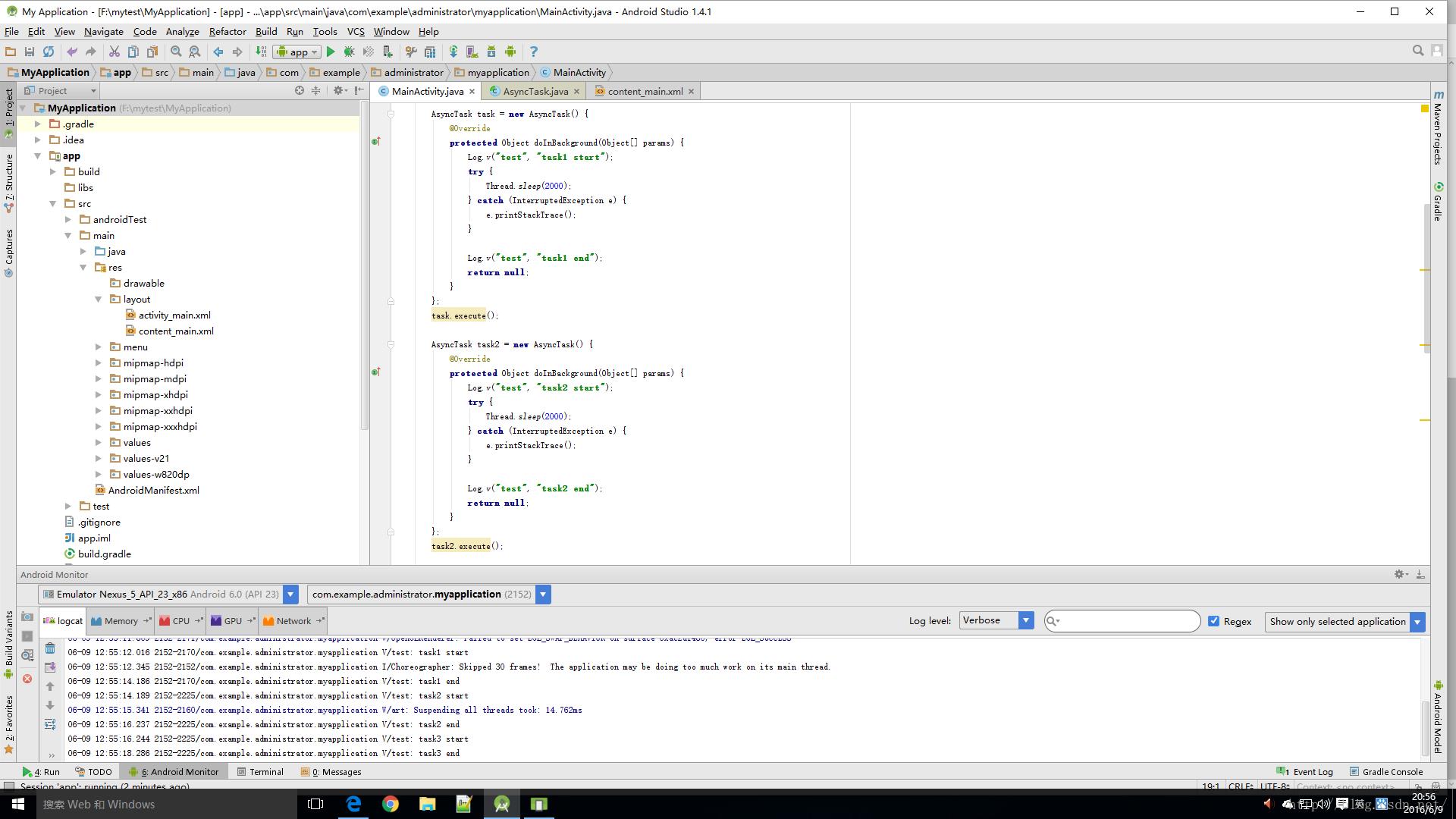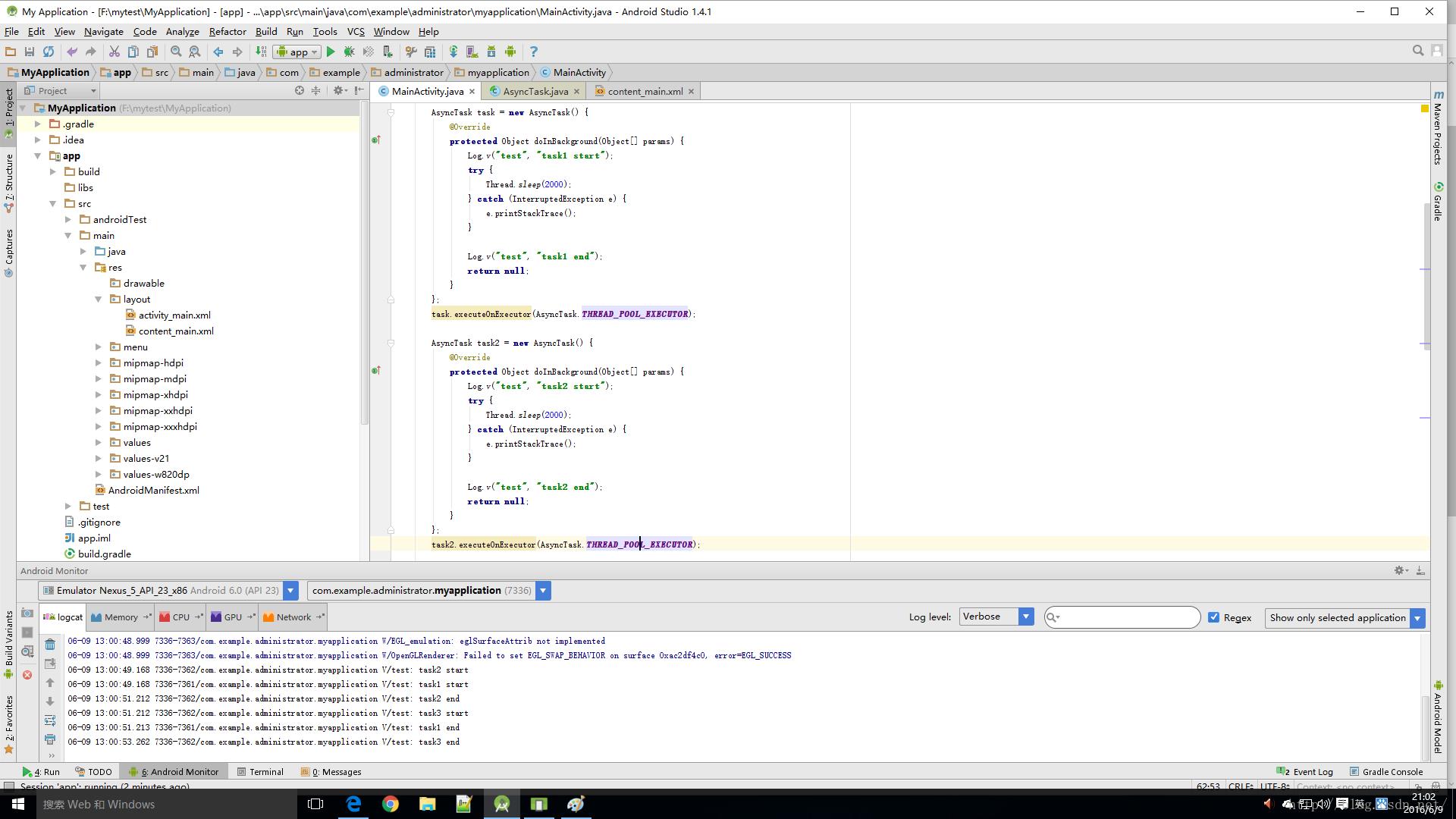AsyncTask 坑 多个task是串行执行还是并行的
Posted zj510
tags:
篇首语:本文由小常识网(cha138.com)小编为大家整理,主要介绍了AsyncTask 坑 多个task是串行执行还是并行的相关的知识,希望对你有一定的参考价值。
AsyncTask作为一个优秀的封装,很多人都在用,可是我估计很多人并不清楚多个AsyncTask对象到底是串行执行的,还是并行执行的,如果是并行的,那么最多同时执行几个异步任务呢? 源码面前无秘密,我们看一下源代码就知道了。 这里以android-23为例。AyncTask调用例子
AsyncTask task = new AsyncTask()
@Override
protected Object doInBackground(Object[] params)
return null;
;
task.execute();AsyncTask的execute函数 看看实现:
@MainThread
public final AsyncTask<Params, Progress, Result> execute(Params... params)
return executeOnExecutor(sDefaultExecutor, params);
超简单,就一行。先看看executeOnExecutor函数:
@MainThread
public final AsyncTask<Params, Progress, Result> executeOnExecutor(Executor exec,
Params... params)
if (mStatus != Status.PENDING)
switch (mStatus)
case RUNNING:
throw new IllegalStateException("Cannot execute task:"
+ " the task is already running.");
case FINISHED:
throw new IllegalStateException("Cannot execute task:"
+ " the task has already been executed "
+ "(a task can be executed only once)");
mStatus = Status.RUNNING;
onPreExecute();
mWorker.mParams = params;
exec.execute(mFuture);
return this;
public static final Executor SERIAL_EXECUTOR = new SerialExecutor();
private static final int MESSAGE_POST_RESULT = 0x1;
private static final int MESSAGE_POST_PROGRESS = 0x2;
private static volatile Executor sDefaultExecutor = SERIAL_EXECUTOR;sDefaultExecutor是SerialExecutor的一个实例,而且它是个静态变量。也就是说,一个进程里面所有AsyncTask对象都共享同一个SerialExecutor对象。 那么所有的秘密就在于SerialExecutor的execute函数了。
SerialExecutor的execute函数 直接贴出SerialExecutor的实现:
private static class SerialExecutor implements Executor
final ArrayDeque<Runnable> mTasks = new ArrayDeque<Runnable>();
Runnable mActive;
public synchronized void execute(final Runnable r)
mTasks.offer(new Runnable()
public void run()
try
r.run();
finally
scheduleNext();
);
if (mActive == null)
scheduleNext();
protected synchronized void scheduleNext()
if ((mActive = mTasks.poll()) != null)
THREAD_POOL_EXECUTOR.execute(mActive);
代码本身很简单,从execute里面就能看出,异步任务r被放到了ArrayDeque对象mTasks中,然后通过scheduleNext()来从mTasks里面得到一个任务去一个后台线程执行。 在一个异步任务执行后,再次调用scheduleNext来执行下一个任务(run函数)。 所以,很清楚,其实SerialExecutor是一个一个执行任务的,而所有的AsyncTask对象又共享同一个SerialExecutor对象(静态成员)。 所以,我们可以肯定: 至少在Android-23 SDK里面,多个AsyncTask对象是串行执行的。 实际是不是呢,做个实验就知道:

测试代码超简单,就是创建3个AsyncTask对象,做了一样的事情,就是在doInBackground里面打印log。 我们从log可以清楚的看到,AsyncTask对象1,2,3是串行执行的。 这也证实了,Android-23 sdk里面 多个AsyncTask对象确实是串行执行的。
如何并行执行多个AsyncTask对象 那么有没有办法并行执行呢?肯定有了。 看AsyncTask的实现,里面有个Executor
public static final Executor THREAD_POOL_EXECUTOR
= new ThreadPoolExecutor(CORE_POOL_SIZE, MAXIMUM_POOL_SIZE, KEEP_ALIVE,
TimeUnit.SECONDS, sPoolWorkQueue, sThreadFactory);
这次的执行顺序跟上次不一样了。可以看出好像3个任务并行执行了。不像之前的排队执行。 关于THREAD_POOL_EXECUTOR,有兴趣可以看进去,大致的意思就是,
private static final int CPU_COUNT = Runtime.getRuntime().availableProcessors();
private static final int CORE_POOL_SIZE = CPU_COUNT + 1;
private static final int MAXIMUM_POOL_SIZE = CPU_COUNT * 2 + 1;实际上,我们也可以自己实现 一个执行器,如:
public class MyThreadPoolExecutor extends AbstractExecutorService以上是关于AsyncTask 坑 多个task是串行执行还是并行的的主要内容,如果未能解决你的问题,请参考以下文章